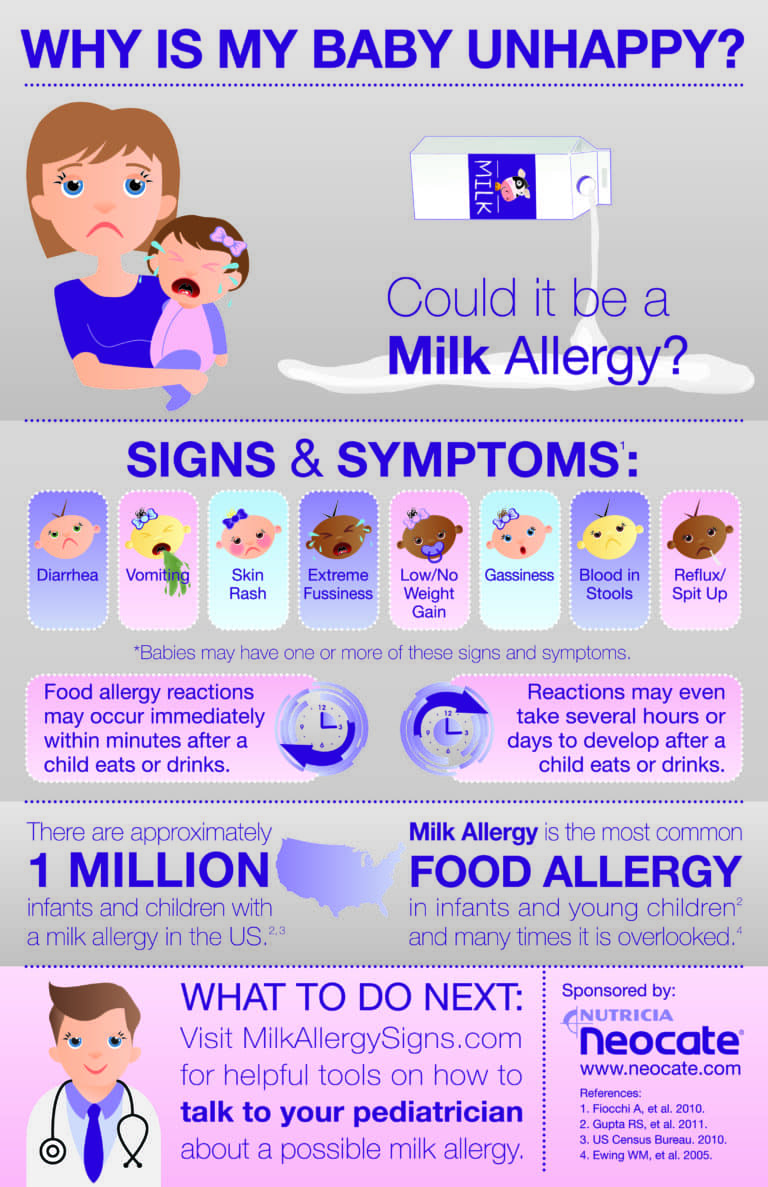According to Food Allergy Research & Education, Inc (FARE), approximately 2.5% of children younger than 3 years of age are allergic to cow milk. Most of these infants and children will outgrow their cow milk allergy, while some may not.
How Do I Know if My Child is Allergic to Cow Milk?
Blood in a child’s stool can be a sign of an allergy to cow milk, and it’s one that you may have heard about, or that your healthcare team may have shared with you. But what are some other signs that your child might be allergic to cow milk?
The following infographic highlights eight common signs and symptoms of a cow milk allergy (CMA), while also providing tips on what parents should look for and next steps if children are exhibiting signs of CMA.

Difference Between Lactose Intolerance and Milk Allergy
Now that we’ve reviewed common CMA signs and symptoms, you might be wondering, What is the difference between CMA and lactose intolerance? The following video from Dr. Adam Fox helps to explain the difference:
Common Signs and symptoms of a Cow Milk Allergy
These signs or symptoms may take anywhere from minutes to hours to days until they appear.
- Skin Rash/Itchy Skin/Hives
- Vomiting
- Extreme fussiness
- Diarrhea
- Excessive Gas
- Wheezing, coughing or other respiratory symptoms
Now, let’s talk about each of these signs in further detail.
Skin Rash/Itchy Skin/Hives
There are many causes of rashes in infants and children. Some are viral, others are due to something in the environment, but some may be due to the food that your child is consuming if he or she has an allergy. If hives develop right after your child has consumed food, it may warrant further investigation into food allergies. The skin around the mouth may be especially itchy if your child has certain food allergies. Note where the rash is and if it seems to bother your child. Remember that old saying, “A picture is worth 1,000 words”. If a rash appears on your child, don’t forget to take a picture and show it to your doctor.
Vomiting
Some babies spit-up after eating if they eat too much, too quickly or a combination of both. They may also vomit due to an illness. By keeping track of your child’s vomiting, it may help to determine if cow milk is the cause of her vomiting.
Extreme Fussiness
The definition of colic applies to healthy, well-fed infants who cry more than 3 hours a day, more than 3 days a week, for more than 3 weeks. Even though these criteria exist, colic is not well defined. The crying and fussiness that we call colic could mean that they are experiencing extreme abdominal pain, and cow milk may be the cause. Investigate extreme fussiness with your pediatrician to determine if there is a change in your child’s diet that may help.
Diarrhea
Diarrhea (and other gastrointestinal symptoms) may be due to the foods your child eats or to an illness. It is important to note when the diarrhea starts and how long it lasts. If diarrhea continues more than 2-4 times per day for more than 5-7 days, it may be a sign of a cow milk allergy. It is also important to note if there is mucus and/or blood in the stool, as these can also indicate a cow milk allergy.
Excessive Gas
Babies can be gassy as their gastrointestinal tracts get used to foods they are consuming. If your child seems excessively gassy and it has a foul odor, it may be a sign of a cow milk allergy, especially when it is in combination with some of these other symptoms.
Wheezing, coughing or other respiratory symptoms
Respiratory symptoms may be a more serious sign of a cow milk allergy and should be taken seriously if you suspect your child has more than a cold. These include wheezing and coughing. If your child starts wheezing or has other respiratory problems after consuming cow milk-containing foods, seek medical attention. More severe than other respiratory symptoms is anaphylaxis, a serious allergic reaction that requires immediate medical attention.
It is best to talk with your healthcare provider if you suspect a food allergy, and keep track of the symptoms with a food diary to help determine what the food allergen may be. The Neocate® Footsteps App can help you keep track of some of these symptoms and allows you to take pictures, if need be, of any skin rashes or other reactions.
Management of a Cow Milk Allergy
If your child is allergic to cow milk, your doctor may recommend a hypoallergenic formula like Neocate to help meet your child’s nutritional needs. Neocate products are available for children of all ages for the dietary management of a cow milk allergy. Just like you’d expect, Neocate is dairy-free! Learn more about available Neocate products.
Can You Outgrow a Milk Allergy?
Most infants and children eventually outgrow a cow milk allergy. However there is no specific age by which this will happen. Each child is unique. Over the years, research has shown that most children will outgrow a cow milk allergy within a few years. For more severe cow milk allergies, research has shown it can take longer. For example, some researchers found that 80% of chidlren they followed with CMA outgrew their allergy by 16 years of age. Read more.
These are just some of the signs and symptoms of a cow milk allergy with a couple frequently asked questions we encounter. When it comes to cow milk allergy, what other questions do you have that we can address in our future posts?
-Ellen







